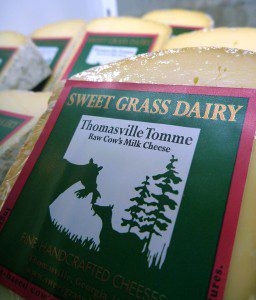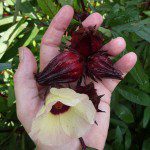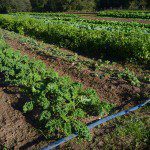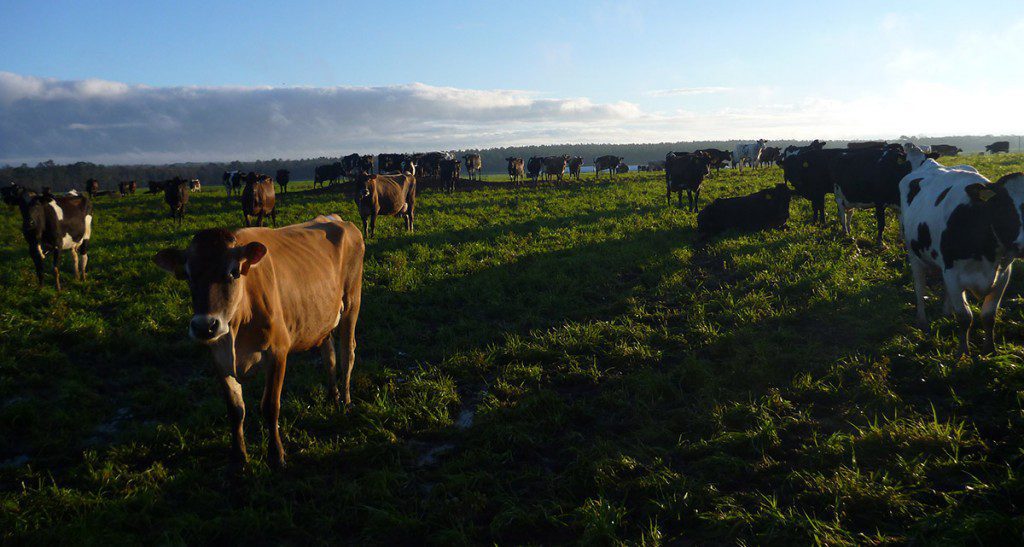Welcome to Part 7 (of 10) of Roaming the Red Hills, which originally aired on the April 14 episode of WFSU’s Local Routes. Through ten 3-minute videos, we’ll explore the natural soul of the Red Hills of Florida and Georgia, from the pine uplands down to its rivers, lakes, and farms. Thanks to Tracy Horenbein for creating original compositions for this video series. The series is narrated by Jim McMurtry.
Funding for Roaming the Red Hills was provided by Tall Timbers Research Station and Land Conservancy.
Rob Diaz de Villegas WFSU-TV
I’m walking on a cow pasture after the rain, and the mud is sometimes hard to distinguish from the cow-pies. My production assistant, Brian, and I set the tripod. When we look up, a couple of hundred cows are all staring at us. Murmurations of birds make their way through the cows and into an adjacent field. A misty sunrise unfolds behind the feed tower at Buddha Belly Dairy in Quitman Georgia.
Buddha Belly was once Green Hill Dairy, where Al and Desiree Wehner started what would become Sweetgrass Dairy (Buddha Belly is now owned by their son Clay). The milk produced by these grass-fed cows will be made into cheese in Thomasville and sold locally or in any of 38 states where Sweetgrass cheeses are shipped.
 A month earlier, I met with Clay’s sister and brother-in-law, Jessica and Jeremy Little, at the Sweetgrass Cheese Shop in Thomasville. The Cheese Shop was hosting a lunch to benefit the Plantation Arts Festival, and new chef Wes Kent created a three course meal for a sold out crowd.
A month earlier, I met with Clay’s sister and brother-in-law, Jessica and Jeremy Little, at the Sweetgrass Cheese Shop in Thomasville. The Cheese Shop was hosting a lunch to benefit the Plantation Arts Festival, and new chef Wes Kent created a three course meal for a sold out crowd.
As Wes prepared the salad, he ran radishes over mandolin. “These are from Breaking Away Farms in Meigs, Georgia.” He sliced aji dulce peppers from Turkey Hill Farm in Tallahassee.
Sweetgrass Dairy, as a local food producer, is a member of the Red Hills Small Farm Alliance. As a restaurant and market, the Cheese Shop uses and sells meat and produce from other member farms. For Jessica, this emphasis on local farms goes back to her own parents’ revelations about the way they raised cows.
After raising cattle conventionally in Asheville, Florida, the Wehners decided to change to a New Zealand “rotational grazing style farm,” and moved their operation to Quitman. They noticed a difference in the flavor of the milk, and after a few years they started making cheeses to showcase what they believed to be a superior product.
With the Cheese Shop, Jessica and Jeremy want to showcase the work that other farmers in the area have put into producing their food products.
“People are working so hard to grow this incredible produce, or to make incredible charcuterie, “Jessica said, “(Jeremy and Wes) just don’t want to mess it up, and let the products speak for themselves.”
The Red Hills Small Farm Alliance
You can see shots in the video above from Turkey Hill and Full Earth Farms. The video is from previous segments where we toured these and other Red Hills Small Farm Alliance Farms.
 Turkey Hill Farms/ Golden Acres Ranch Louise Divine is co-owner of Turkey Hill and co-founder of the Red Hills Small Farm Alliance. Between clipping roselle flowers (pictured to the left, roselle flowers are used to make red zinger tea) and harvesting ginger root, she talked to us how she inadvertently started farming for a living and about what the RHSFA does for local farmers. At Golden Acres, in Monticello, Florida, Bobby Golden introduces us to the many animals she raises, including Tennessee Fainting Goats.
Turkey Hill Farms/ Golden Acres Ranch Louise Divine is co-owner of Turkey Hill and co-founder of the Red Hills Small Farm Alliance. Between clipping roselle flowers (pictured to the left, roselle flowers are used to make red zinger tea) and harvesting ginger root, she talked to us how she inadvertently started farming for a living and about what the RHSFA does for local farmers. At Golden Acres, in Monticello, Florida, Bobby Golden introduces us to the many animals she raises, including Tennessee Fainting Goats.
 Full Earth Farm/ Blue Ridge Farm/ Miccosukee Root Cellar Katie Harris is the other co-founder of the RHSFA, and co-owner of Full Earth Farm in Quincy, Florida. When we visited, they were harvesting sweet potatoes and had rows of greens growing (pictured, left). At Blue Ridge Farm in Havana, Florida, Wayne Hawthorne shows us his hydroponic greenhouse. And, at the Miccosukee Root Cellar in Tallahassee, Ruben Fields runs a farm to table restaurant using Red Hills farms. If you watched the segment above on Local Routes, Ruben might look familiar. You can see him playing and singing in our music segment with his band, Two Foot Level.
Full Earth Farm/ Blue Ridge Farm/ Miccosukee Root Cellar Katie Harris is the other co-founder of the RHSFA, and co-owner of Full Earth Farm in Quincy, Florida. When we visited, they were harvesting sweet potatoes and had rows of greens growing (pictured, left). At Blue Ridge Farm in Havana, Florida, Wayne Hawthorne shows us his hydroponic greenhouse. And, at the Miccosukee Root Cellar in Tallahassee, Ruben Fields runs a farm to table restaurant using Red Hills farms. If you watched the segment above on Local Routes, Ruben might look familiar. You can see him playing and singing in our music segment with his band, Two Foot Level.
Come adventure with us in the Red Hills, Apalachicola River and Bay, the Forgotten Coast, and More! Subscribe to the WFSU Ecology Blog by Email.

